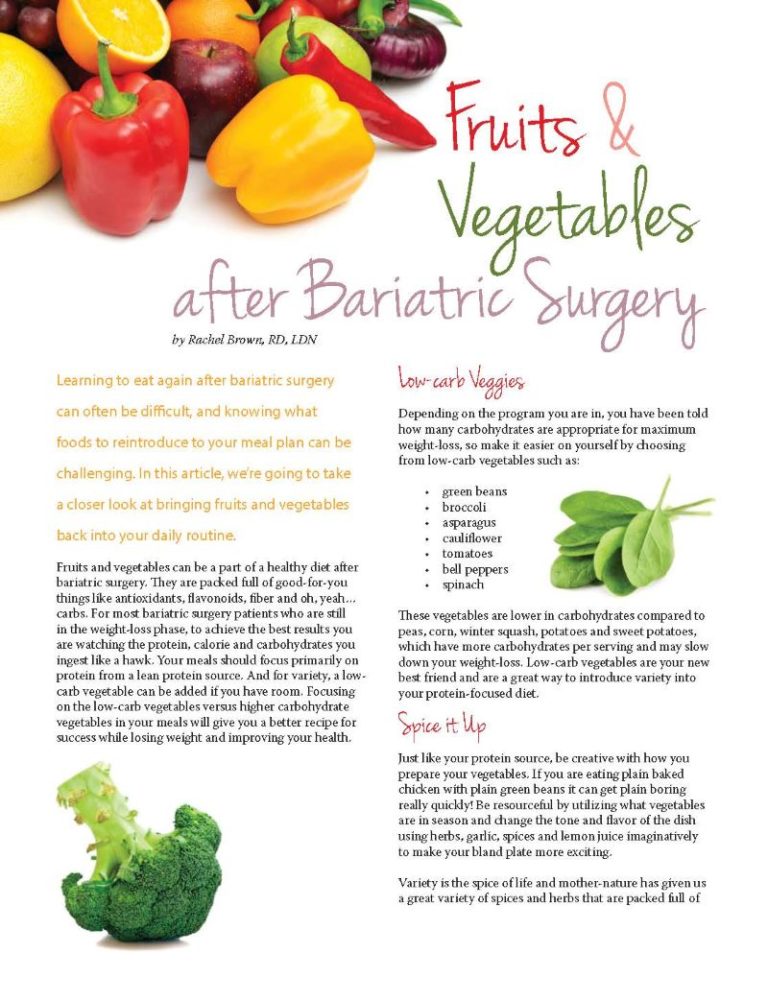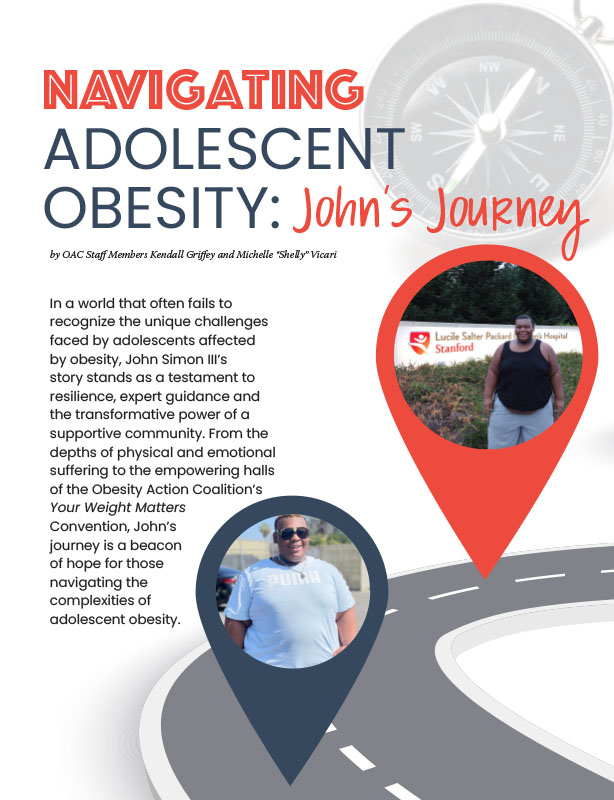Fruits & Vegetables after Bariatric Surgery


by Rachel Brown, RD, LDN
Spring 2013
Learning to eat again after bariatric surgery can often be difficult, and knowing what foods to reintroduce to your meal plan can be challenging. In this article, we’re going to take a closer look at bringing fruits and vegetables back into your daily routine.
Fruits and vegetables can be a part of a healthy diet after bariatric surgery. They are packed full of good-for-you things like antioxidants, flavonoids, fiber and oh, yeah…carbs. For most bariatric surgery patients who are still in the weight-loss phase, to achieve the best results you are watching the protein, calorie and carbohydrates you ingest like a hawk. Your meals should focus primarily on protein from a lean protein source. And for variety, a low-carb vegetable can be added if you have room. Focusing on the low-carb vegetables versus higher carbohydrate vegetables in your meals will give you a better recipe for success while losing weight and improving your health.
Low-carb Veggies
Depending on the program you are in, you have been told how many carbohydrates are appropriate for maximum weight-loss, so make it easier on yourself by choosing from low-carb vegetables such as:
-
-
- green beans
- broccoli
- asparagus
- cauliflower
- tomatoes
- bell peppers
- spinach
-
These vegetables are lower in carbohydrates compared to peas, corn, winter squash, potatoes and sweet potatoes, which have more carbohydrates per serving and may slow down your weight-loss. Low-carb vegetables are your new best friend and are a great way to introduce variety into your protein-focused diet.
Spice it Up
Just like your protein source, be creative with how you prepare your vegetables. If you are eating plain baked chicken with plain green beans it can get plain boring really quickly! Be resourceful by utilizing what vegetables are in season and change the tone and flavor of the dish using herbs, garlic, spices and lemon juice imaginatively to make your bland plate more exciting.
Variety is the spice of life and mother nature has given us a great variety of spices and herbs that are packed full of flavor and are naturally calorie-free! Look through your spice cabinet, if there is a spice you have never used before or have not touched in a long time, use it on your protein or low-carb vegetable for an exciting new twist on an old staple. Fresh or frozen low-carb veggies are the better choice instead of the canned versions. If you must use canned, drain and rinse to get off the unnecessary excess salt the manufacturers added to preserve the vegetable, and next time buy the fresh or frozen version.
Following the Guidelines
Each bariatric surgery center has a unique set of guidelines particular to that program, so be sure to follow your surgery center’s instructions on fruit and vegetable intake and what is allowed. To help avoid any difficulties, avoid raw fruits and vegetables the first three months after bariatric surgery and eat them cooked until that point. After the first three months, you are welcome to enjoy eating salads (iceberg is not tolerated as well as romaine or spinach) and raw vegetables to compliment your protein. Lettuce wraps are a great way to change up your protein and add a little low-carb crunch!
Fruit should be eaten sparingly for maximum weight-loss or wait until your goal weight to add the extra carbs that come with eating fruit. The average serving of fruit has about 15 grams of carbohydrates, which can add up quickly throughout the day. In the meantime, get your fruit flavor fix by adding sugar-free jelly/preserves to a high-protein plain Greek yogurt to get all the fruit flavor without the added carbs. If you are at your goal weight and can add more carbs into your diet, chose from lower carbohydrate fruits, such as watermelon, grapefruit and cantaloupe. Higher carbohydrate fruits include bananas, apples, cherries and pineapple.
Maximize Your Meals
Nature is hinting to us to be creative and use the all-natural herbs, spices, lemon and garlic to transform ordinary vegetables into a unique and flavorful dish. Maximize your variety by choosing fruits and vegetables that are in season for the best flavors and textures. Search for what fruits and vegetables are in season online or at your local grocer. Vary your vegetables not only in the way you spice them, but vary in their colors too. For example, if you only are accustomed to eating green bell peppers, branch out and try the red, orange and yellow varieties. You will not only get a more colorful plate, but you will be getting a variety of different antioxidants that vegetables are celebrated for in their health benefits.
Fresh Fruit Recipe
(goal weight or weight maintenance phase)
Amount per serving: 1 – Calories 100 – Total Carbs 7 grams – Protein 18 grams
Ingredients:
-
-
- 1 6-ounce container of plain, 0 percent fat, Greek yogurt
- 1 teaspoon ground cinnamon
- 2 teaspoons vanilla extract
- 4 packets sugar substitute
-
Directions:
-
-
- Stir vanilla extract and cinnamon into Greek yogurt.
- Add sugar substitute to taste and dip fresh fruit into the dip for great way to get some protein in while eating fruit!
-
Caprese Salad Recipe
(three months post-op)
Amount per serving: 1 – Calories 205 – Total Carbs 10 grams – Protein 16 grams
Ingredients:
-
-
- Part skim mozzarella cheese-sliced
- Fresh tomatoes (4 sliced)
- Sea salt/cracked black pepper
- Fresh basil leaves
- Balsamic vinegar or fat free Italian dressing
-
Directions:
-
-
- Stack mozzarella and sprinkle salt and pepper.
- Top with a basil leaf or two-stack tomato slice on top and alternate stacking cheese, basil, tomato, salt and pepper and drizzle with balsamic vinegar or dressing.
-
Green Beans Tossed with Scallions, Garlic, Tarragon and Vinegar
Amount per serving: 2 – Calories 32.4 – Total Carbs 5.9 grams
Ingredients:
-
-
- 8 ounce fresh green beans (stem ends removed)
- 1 olive oil cooking spray
- 1 scallion (white part plus 1 inch green, finely chopped)
- 1 medium garlic clove (minced)
- ½ teaspoon fresh tarragon (chopped)
- 1 pinch black pepper
- 1 teaspoon white vinegar
-
Directions:
-
-
- Cook the beans in boiling water for three minutes.
- Drain and place back in the saucepan.
- Spray the beans with the cooking spray and then add the scallion, garlic, herbs, pepper and white vinegar.
- Toss to mix.
-
About the Author:
Rachel Brown, RD, LDN, is a registered dietitian at the Centennial Center for the Treatment of Obesity in Nashville, Tenn. She counsels weight-loss patients, pre and post-op, on their journey to healthier lives.
by Sarah Muntel, RD Spring 2024 Spring has sprung, bringing sunnier and warmer days! For many, this…
Read Articleby OAC Staff Members Kendall Griffey and Michelle “Shelly” Vicari Winter 2024 In a world that often…
Read Articleby Sarah Ro, MD; and Young Whang, MD, PhD Fall 2023 Mary, a postmenopausal woman with a…
Read Article








